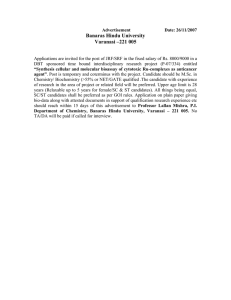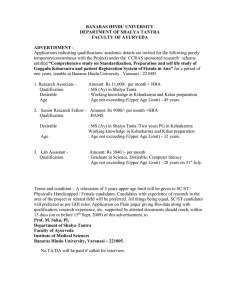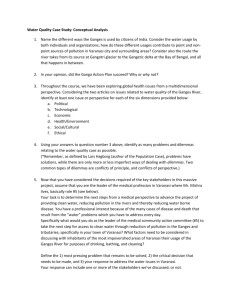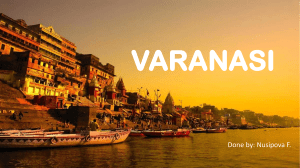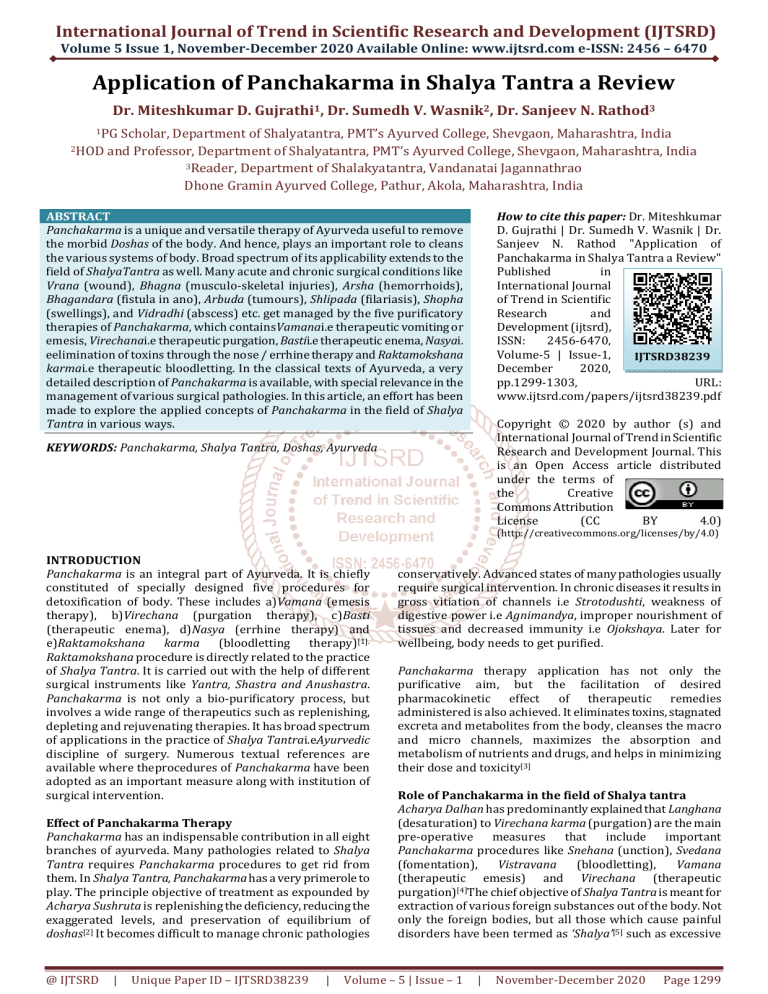
International Journal of Trend in Scientific Research and Development (IJTSRD) Volume 5 Issue 1, November-December 2020 Available Online: www.ijtsrd.com e-ISSN: 2456 – 6470 Application of Panchakarma in Shalya Tantra a Review Dr. Miteshkumar D. Gujrathi1, Dr. Sumedh V. Wasnik2, Dr. Sanjeev N. Rathod3 1PG 2HOD Scholar, Department of Shalyatantra, PMT’s Ayurved College, Shevgaon, Maharashtra, India and Professor, Department of Shalyatantra, PMT’s Ayurved College, Shevgaon, Maharashtra, India 3Reader, Department of Shalakyatantra, Vandanatai Jagannathrao Dhone Gramin Ayurved College, Pathur, Akola, Maharashtra, India How to cite this paper: Dr. Miteshkumar D. Gujrathi | Dr. Sumedh V. Wasnik | Dr. Sanjeev N. Rathod "Application of Panchakarma in Shalya Tantra a Review" Published in International Journal of Trend in Scientific Research and Development (ijtsrd), ISSN: 2456-6470, Volume-5 | Issue-1, IJTSRD38239 December 2020, pp.1299-1303, URL: www.ijtsrd.com/papers/ijtsrd38239.pdf ABSTRACT Panchakarma is a unique and versatile therapy of Ayurveda useful to remove the morbid Doshas of the body. And hence, plays an important role to cleans the various systems of body. Broad spectrum of its applicability extends to the field of ShalyaTantra as well. Many acute and chronic surgical conditions like Vrana (wound), Bhagna (musculo-skeletal injuries), Arsha (hemorrhoids), Bhagandara (fistula in ano), Arbuda (tumours), Shlipada (filariasis), Shopha (swellings), and Vidradhi (abscess) etc. get managed by the five purificatory therapies of Panchakarma, which containsVamanai.e therapeutic vomiting or emesis, Virechanai.e therapeutic purgation, Bastii.e therapeutic enema, Nasyai. eelimination of toxins through the nose / errhine therapy and Raktamokshana karmai.e therapeutic bloodletting. In the classical texts of Ayurveda, a very detailed description of Panchakarma is available, with special relevance in the management of various surgical pathologies. In this article, an effort has been made to explore the applied concepts of Panchakarma in the field of Shalya Tantra in various ways. Copyright © 2020 by author (s) and International Journal of Trend in Scientific Research and Development Journal. This is an Open Access article distributed under the terms of the Creative Commons Attribution License (CC BY 4.0) KEYWORDS: Panchakarma, Shalya Tantra, Doshas, Ayurveda (http://creativecommons.org/licenses/by/4.0) INTRODUCTION Panchakarma is an integral part of Ayurveda. It is chiefly constituted of specially designed five procedures for detoxification of body. These includes a)Vamana (emesis therapy), b)Virechana (purgation therapy), c)Basti (therapeutic enema), d)Nasya (errhine therapy) and e)Raktamokshana karma (bloodletting therapy)[1]. Raktamokshana procedure is directly related to the practice of Shalya Tantra. It is carried out with the help of different surgical instruments like Yantra, Shastra and Anushastra. Panchakarma is not only a bio-purificatory process, but involves a wide range of therapeutics such as replenishing, depleting and rejuvenating therapies. It has broad spectrum of applications in the practice of Shalya Tantrai.eAyurvedic discipline of surgery. Numerous textual references are available where theprocedures of Panchakarma have been adopted as an important measure along with institution of surgical intervention. Effect of Panchakarma Therapy Panchakarma has an indispensable contribution in all eight branches of ayurveda. Many pathologies related to Shalya Tantra requires Panchakarma procedures to get rid from them. In Shalya Tantra, Panchakarma has a very primerole to play. The principle objective of treatment as expounded by Acharya Sushruta is replenishing the deficiency, reducing the exaggerated levels, and preservation of equilibrium of doshas[2] It becomes difficult to manage chronic pathologies @ IJTSRD | Unique Paper ID – IJTSRD38239 | conservatively. Advanced states of many pathologies usually require surgical intervention. In chronic diseases it results in gross vitiation of channels i.e Strotodushti, weakness of digestive power i.e Agnimandya, improper nourishment of tissues and decreased immunity i.e Ojokshaya. Later for wellbeing, body needs to get purified. Panchakarma therapy application has not only the purificative aim, but the facilitation of desired pharmacokinetic effect of therapeutic remedies administered is also achieved. It eliminates toxins, stagnated excreta and metabolites from the body, cleanses the macro and micro channels, maximizes the absorption and metabolism of nutrients and drugs, and helps in minimizing their dose and toxicity[3] Role of Panchakarma in the field of Shalya tantra Acharya Dalhan has predominantly explained that Langhana (desaturation) to Virechana karma (purgation) are the main pre-operative measures that include important Panchakarma procedures like Snehana (unction), Svedana (fomentation), Vistravana (bloodletting), Vamana (therapeutic emesis) and Virechana (therapeutic purgation)[4]The chief objective of Shalya Tantra is meant for extraction of various foreign substances out of the body. Not only the foreign bodies, but all those which cause painful disorders have been termed as ‘Shalya’[5] such as excessive Volume – 5 | Issue – 1 | November-December 2020 Page 1299 International Journal of Trend in Scientific Research and Development (IJTSRD) @ www.ijtsrd.com eISSN: 2456-6470 accumulation of mala (excreta/toxins) and dosha (Vata, Pitta, Kapha). Acharya Sushruta has elaborated the procedures of Panchkarma in ChikitsaSthana along with preprocedure preparations, complications and management. Major surgical conditions requiring Panchakarma procedures are described as under: Vrana (Wounds): Wound management is the most vital part of practice of Shalya Tantra. Etiological classification of vrana (wounds) constitutes Nija/Shareeravrana (intrinsic wounds-caused by vitiation ofdosha) or Agantujavrana (exogenous wounds or traumatic wounds)[6]Panchakarma procedures have a significant place in the management of both these types of wounds. In case of many casualties due to severe haemorrhage in case of Chhinna (excised), Bhinna (ruptured), Vidhha (punctured) and Kshata (lacerated) wounds, vatadoshagets aggravated resulting in severe pain. For this vitiatedvatadosha, Sneha-pana(unction therapy), Snigdhaupanahana (local application of unctuous poultices), Snehabasti (medicated unctuous enemas) are specifically indicated[7] All the Panchakarma procedures have been included under ‘Shashti Upkrama’ (sixty modalities) of wound management as described by Sushruta. More specifically the indications for individual procedures includes as, Snehana Karma (Unction Therapy): Consumption of Sneha processed with specified drugs has been indicated in patients who have complications due to wound [8] In all such conditions, there is gross aggravation of Vatadosha, that gets cured easily by Snehana karma. Svedana Karma (Sudation Therapy): Different types of fomentations has been indicated in inflammatory swellings for local application which are painful, hard.[9] Vaman Karma (Therapeutic Emesis): It is an excellent therapy for minimisation of vitiated Kaphadosha. In case of wounds having inflammation along with granulation tissue and vitiated darkish blood, vamana karma is useful particularly in that caused by vitiated Kaphadosha[10] VirechanaKarma (Therapeutic Purgation: Virechana karma is choice of treatment in wounds vitiated with pitta associated with vata and which are chronic in duration [11] Basti Karma (Medicated Enema): The wounds which are rough, severely vitiated by vata and is particularly situated in the lower part of the body, basti is indicated in such cases[12] suppuration. It is particularly indicated in the wounds with inflammation, hardness, dark-red discoloration, pain i.e. in DushtaVrana. In poisoned wounds as well, bloodletting has been prescribed with leeches[15] While describing the management of wounds, Acharya Charaka has explained that evacuation with Vamana, Virechana, Shastra karma and Basti karma are the main treatment modalities that should be adopted; because the wounds get pacified quickly[16] Component of Infection: In Surgical practice, the infection is of vital importance. Prevention of wound from infection and management of infected wounds is a potential challenge to the surgeons of modern times as well. Ayurveda has special way of management of Dushtavrana (infected wound) that chiefly incorporates the procedures of Panchakarma. ArshaChikitsa (Haemorrhoids): Arsha is one of the main and common pathologies related to the field of Shalya Tantra. The Nidanasamprapti (aetio-pathogenesis) of Arsha includes Manda-agnii.esuppression of digestive fire and Malavashtambhai.eexcessive accumulation of excrements [17] Panchakarma is absolute indication for its effective management. In the context of VatajArsha, snehan, swedana, virechana, anuvasana and asthapanabasti have been indicated. Also in Pittaj Arsha, virechana karma has been mentioned as one of the main treatments[18]. Parikartika (Anal Fissures): Pichhabasti and snehabasti i.e Anuvasnabasti have been indicated in Parikartikai.e anal fissures[19]. Local soothing and wound healing is certainly achieved by medicated enemas. And ultimately by its beauty of action, it is effective in relieving the condition as well. Bhagandara (Fistula in Ano): Various Svedana karma and Virechana have been indicated in Bhagandara (fistula in ano). The glory of panchakarma reflects here by helping in Sampraptibhanga (breaking the chain of pathogenesis at its root) and helps to remove the vitiateddoshas. Specifically, in Kaphaj type (ParistraviBhagandra), mild virechana followed by TikshnaVirechana have been advised to be administered.[20] Gud-Bhransha (Prolapse of Rectum): Administration of Pichhabasti (slimy enema) has the indication in rectal prolapse and bleeding per anum.[21] In Charak and SushrutSamhita, the varieties of PichhaBasti have been mentioned. Uttar Basti Karma (Douches): This is particularly applied through urinary path mostly in retention of urine, disorders of urine and semen, wounds caused by calculus and in menstrual disorders; administration of Uttarbasti is helpful[13] AshmariChikitsa (Urinary Calculus) : Post-operative Svedana Karma (sudation), Uttar Basti (urethral douche), Asthapana (medicated enema) and AnuvasnaBasti (unctuous enemas) are the main Panchakarma procedures indicated in management of this illness.[22] These procedures help in preventing and relieving the post-operative pain and complications. Shiro-virechana Karma (Errhine Therapy):The wounds and swellings which are located in supraclavicular region i.e urdhava-jatrugatavrana requires special management with Shiro-virechana karma.[14] Shopha (Oedema): By monitoring the level of vitiation of Doshas, and mode of Samprapti (pathogenesis)Snehana, Svedana, Upnahanaalong with frequent Sira-vedha definitely give the good results.[23] Raktamokshana Karma (Therapeutic Bloodletting): In acute inflammatory swellings, Raktamokshana karma is certainly effective in reducing pain and to prevent Bhagna (Musculo-Skeletal Injuries): As mentioned in Samhitas, Asthi (bones and cartilages) are one of the main seats of Vatadosha. Aaghat (Trauma)at these sites result in @ IJTSRD | Unique Paper ID – IJTSRD38239 | Volume – 5 | Issue – 1 | November-December 2020 Page 1300 International Journal of Trend in Scientific Research and Development (IJTSRD) @ www.ijtsrd.com eISSN: 2456-6470 aggravation of local vata. The Panchkarma procedures have a good role to play here. Dhara (allowing oil to flow in to and fro manner from certain distance with certain velocity), Abhyang (gently application of oil) and Basti karma in the management of bhagna (fractures). AnuvasnaBasti gives fascinating results inprashakhabhagna (fractures of extremities), Application of Nasya karma in fractures and dislocations involving the parts above neck helps fast recovery, Svedana and Nasya karma in dislocation of Hanu (mandible) is also helpful.[24] PramehaPidika (Diabetic Boils): Management of this by the treatment with Vamana,Virechana and Siravedha has been prescribed along with surgical intervention. In the patients suffering from Madhumeha (Diabetes mellitus), for easy excretion of vitiated doshas, the administration of drastic purgatives has been advised.[25] Apachi (Scrofula), Granthi, Arbuda (Tumours): Ghritapana, Tailapanai.eoral administration of medicated ghee and oil, svedana karma along with main Panchakarma procedures constitute the general management of all these conditions.[26] In advanced scrofula, medicated ghee should be administered to the patient to eliminate vitiated Doshas from both ways (emesis and purgation). Shirovirechana karma has also been included.[27] GranthiRoga (Cystic Lesions): In vatajgranthi, different types of poultices are useful to minimise the local symptoms. In Pittajgranthi, bloodletting with leeches plays a vital role.[28] ShlipadaRoga(Elephantiasis) Raktamokshana by Siravyadha has been indicated to get rid of impurities in the blood and in the management of all the three types of Shlipada[29] PranashtaShalya (Retained Foreign Bodies): Out of total 15 methods of extraction of retained foreign bodies, vaman, virechana, dhmapanaare the procedures are helpful.[30] Vidradhi (Abscess): In addition to the surgical interventions like incision and drainage, Panchakarma procedures are also beneficial.[31]Acharya Sushrutahas prescribed Panchakarma therapies according to stage and involvement of Dosha. UdaraRoga (Abdominal Enlargements): For the management of aggravated Vata and accumulated Mala (excrements) in all types of Udararogafrequent purgation is very useful.[32] The administration of medicated enemas is particularly helpful in getting rid of waste deposits in the body. Yakridalyodara(Enlargement of Liver) and PleehodaraRoga (Spleenomegaly) Siravedha (venepuncture) has been indicated after Snehana and Svedana.[33] Both Yakrut (liver) and Pleeha (spleen) are the seat of Rakta-vahastrotasa. Bloodletting directly corrects the vitiatedRakta. Vridhhi/Bradhna (Hernias): Acharya Sushruthas indicated Raktamokshana by Siravedha (venepuncture), although its effects are still undetermined [34]. Similarly, in the context of @ IJTSRD | Unique Paper ID – IJTSRD38239 | Bradhna (inguinal hernia), Virechana and NiruhaBasti have been mentioned as the main treatment[35]. AtyayikaChikitsa (Emergency Management) :Emergency management is an integral part of Surgery. Acharya Sushruta has indicated the procedure of Siravyadha (venepuncture) to relieve acute conditions by its fast action. Raktamokshanaby Siravyadha has been said to contribute as half of the total surgical management.[36]In the management of excessive blood loss, Rakta-basti (enema with blood) has been indicated as an effective major.[37] In the management of Dhoom-op-hata (suffocation by smoke), vaman and shirovirechana help to evacuate the accumulated toxins.[38] For managing the condition of ‘Bahurajju-lata pasha kanthapeedana’ (throatling), there has been a prime indication for Shirovirechana.[39] Intake of incompatible food has been described to be treated by Panchkarma, mainly by vamanand virechana. Similarly in poisoning cases, the unique management method is Panchakarma. In Dushivisha or poisons situated in blood, venepuncture along with all the five evacuative measures of Panchakarma have been advised by Acharya Charaka.[40] CONCLUSION: Panchakarma has an international recognition as major and unique therapy in the preservation, maintenance and conservation of health, along with promotion of longevity. In the field of Shalya Tantra, the procedures of Panchakarma plays a very important role. Successful peri-operative management of numerous surgical conditions requires adjuvant therapies of Panchakarma. By adopting these procedures, the practice of Shalya Tantra is sure to be benefitted with improved outcomes. REFERENCES: [1] Ravi DuttTripathi. Hindi Commentary on AstangaSamgraha, Part I, Sutra Sthana, Chapter 24/7, 1st ed. Chaukhambha Sanskrit Pratishthan, Dehli, 1996; p 435. [2] Priyavrat Sharma. Editor and Translator of Sushruta Samhita, Volume II, ChikitsaSthana, Chapter 33/3, Reprint 1st edition, ChaukhambhaVisvabharati, Varanasi, 2013; p 573. [3] http://ijapr.in/index.php/ijapr/article/download/31 8/331 [4] Keval Krishan Thakral. Hindi Translator of commentaries of NibandhaSamgraha of Dalhana Acharya and Nyaya Chandrika of Gaya Dasa on Sushruta Samhita, Part I, Sutra Sthana, Chapter 5/3, 1st edition, ChaukhambhaOrientalia, Varanasi, 2014; p 48-49. [5] Priyavrat Sharma. Editor and Translator of Sushruta Samhita, Volume I, Sutra Sthana, Chapters 1/7, Reprint 1st edition, ChaukhambhaVisvabharati, Varanasi, 2013; p8. [6] Priyavrat Sharma. Editor and Translator of Sushruta Samhita, Volume II, ChikitsaSthana, Chapter 1/3, 1st edition (reprint). ChaukhambhaVisvabharati, Varanasi, 2013; p 245. Volume – 5 | Issue – 1 | November-December 2020 Page 1301 International Journal of Trend in Scientific Research and Development (IJTSRD) @ www.ijtsrd.com eISSN: 2456-6470 [7] Priyavrat Sharma. Editor and Translator of Sushruta Samhita, Volume II, ChikitsaSthana, Chapter 2/23-25, 1st edition (reprint). ChaukhambhaVisvabharati, Varanasi, 2013; p 278. [20] Priyavrat Sharma. Editor and Translator of Sushruta Samhita, Volume II, ChikitsaSthana, Chapter 8/27, 1st edition (reprint). ChaukhambhaVisvabharati, Varanasi, 2013; p 353. [8] Priyavrat Sharma. Editor and Translator of Sushruta Samhita, Volume II, ChikitsaSthana, Chapter 1/30, 1st edition (reprint). ChaukhambhaVisvabharati, Varanasi, 2013; p 255. [21] Priyavrat Sharma. Editor and Translator of Charakaa Samhita, Volume II, ChikitsaSthana, Chapter 14/224229, 1st edition (reprint). ChaukhambhaVisvabharati, Varanasi, 2010; p 246-247. [9] Priyavrat Sharma. Editor and Translator of Sushruta Samhita, Volume II, ChikitsaSthana, Chapter 1/21, 1st edition (reprint). ChaukhambhaVisvabharati, Varanasi, 2013; p 253. [22] Priyavrat Sharma. Editor and Translator of Sushruta Samhita, Volume II, ChikitsaSthana, Chapter 7/35, 1st edition (reprint). ChaukhambhaVisvabharati, Varanasi, 2013; p 345. [10] Priyavrat Sharma. Editor and Translator of Sushruta Samhita, Volume II, ChikitsaSthana, Chapter 1/31, 1st edition (reprint). ChaukhambhaVisvabharati, Varanasi, 2013; p 255. [23] Priyavrat Sharma. Editor and Translator of Sushruta Samhita, Volume II, ChikitsaSthana, Chapter 23/12, 1st edition (reprint). ChaukhambhaVisvabharati, Varanasi, 2013; p 488. [11] Priyavrat Sharma. Editor and Translator of Sushruta Samhita, Volume II, ChikitsaSthana, Chapter 1/32, 1st edition (reprint). ChaukhambhaVisvabharati, Varanasi, 2013; p 255. [24] Priyavrat Sharma. Editor and Translator of Sushruta Samhita, Volume II, ChikitsaSthana, Chapter 3/54, 28, 39, 40 1st edition (reprint). ChaukhambhaVisvabharati, Varanasi, 013; p 295297,300. [12] Priyavrat Sharma. Editor and Translator of Sushruta Samhita, Volume II, ChikitsaSthana, Chapter 1/108, 1st edition (reprint). ChaukhambhaVisvabharati, Varanasi, 2013; p 269. [25] Priyavrat Sharma. Editor and Translator of Sushruta Samhita, Volume II, ChikitsaSthana, Chapter 12/4, 1st edition (reprint). ChaukhambhaVisvabharati, Varanasi, 2013; p 389-390. [26] Priyavrat Sharma. Editor and Translator of Sushruta Samhita, Volume II, ChikitsaSthana, Chapter 18/2023, 1st edition (reprint). ChaukhambhaVisvabharati, Varanasi, 2013; p 435. [27] Priyavrat Sharma. Editor and Translator of Sushruta Samhita, Volume II, ChikitsaSthana, Chapter 4/39-40, 1st edition (reprint). ChaukhambhaVisvabharati, Varanasi, 2013; p 439-440. [28] Priyavrat Sharma. Editor and Translator of Sushruta Samhita, Volume II, ChikitsaSthana, Chapter 18/6,8, 1st edition (reprint). ChaukhambhaVisvabharati, Varanasi, 2013; p 436,437. [29] Priyavrat Sharma. Editor and Translator of Sushruta Samhita, Volume II, ChikitsaSthana, Chapter 19/52, 55, 56, 1st edition (reprint). ChaukhambhaVisvabharati, Varanasi, 2013; p 456458. [30] Priyavrat Sharma. Editor and Translator of Charakaa Samhita, Volume I, Sutra Sthana, Chapter 27/ 4, 1st edition (reprint). ChaukhambhaVisvabharati, Varanasi, 2011; p 274. [31] Acharya G. Shrinivasa. Panchakarma Illustrated, 1st edition (reprint). Chaukhambha Sanskrit Pratishthan, Delhi, 2013; p 18. [32] Priyavrat Sharma. Editor and Translator of Sushruta Samhita, Volume II, ChikitsaSthana, Chapter 14/9, 1st edition (reprint). ChaukhambhaVisvabharati, Varanasi, 2013; p 402. [13] [14] [15] [16] [17] [18] [19] Priyavrat Sharma. Editor and Translator of Sushruta Samhita, Volume II, ChikitsaSthana, Chapter 1/109, 1st edition (reprint). ChaukhambhaVisvabharati, Varanasi, 2013; p 269. Priyavrat Sharma. Editor and Translator of Sushruta Samhita, Volume II, ChikitsaSthana, Chapter 1/124, 1st edition (reprint). ChaukhambhaVisvabharati, Varanasi, 2013; p 271. Priyavrat Sharma. Editor and Translator of Sushruta Samhita, Volume II, ChikitsaSthana, Chapter 1/27-29, 1st edition (reprint). ChaukhambhaVisvabharati, Varanasi, 2013; p 254-255. Priyavrat Sharma. Editor and Translator of Charakaa Samhita, Volume II, ChikitsaSthana, Chapter 25 /38, 1st edition (reprint). ChaukhambhaVisvabharati, Varanasi, 2010; p 412. AmbikadattaShastri, translator, Ayurvedatatvasandeepika Hindi commentary on Sushruta Samhita, Part I, NidanaSthana, Chapter 2/4, 2nd ed. Chaukhambha Sanskrit Sansthana, Varanasi, 2012; p 187. Priyavrat Sharma. Editor and Translator of Sushruta Samhita, Volume II, ChikitsaSthana, Chapter 6/16, 1st edition (reprint). ChaukhambhaVisvabharati, Varanasi, 2013; p 336. P.V. Sharma. Editor-Translator of Charaka Samhita, Volume II, SidhhiSthana, Chapter 6/67, 1 st edition, Reprint, Chaukhambha Orientalia, Varanasi, 2010; p 629. @ IJTSRD | Unique Paper ID – IJTSRD38239 | Volume – 5 | Issue – 1 | November-December 2020 Page 1302 International Journal of Trend in Scientific Research and Development (IJTSRD) @ www.ijtsrd.com eISSN: 2456-6470 [33] Priyavrat Sharma. Editor and Translator of Sushruta Samhita, Volume II, ChikitsaSthana, Chapter 14/13,15 1st edition (reprint). ChaukhambhaVisvabharati, Varanasi, 2013; p 405-406. [34] AmbikadattaShastri, translator, Ayurvedatatvasandeepika Hindi commentary on Sushruta Samhita, Part I, ChikitsaSthana, Chapter 19/24, 2nd edition (reprint) Chaukhambha Sanskrit Sansthana, Varanasi, 2012; p112. [35] P. V. Sharma. Editor-Translator of Charaka Samhita, Volume II, ChikitsaSthana, Chapter 12/95, 1 stedition, Reprint, ChaukhambhaOrientalia, Varanasi, 2010; p 201. [36] Priyavrat Sharma. Editorand Translator of Sushruta Samhita, Volume II, ShareeraSthana, Chapter 8/22-23, 15 1stedition (reprint). ChaukhambhaVisvabharati, Varanasi, 2013; p 214. [37] K. Shastri and G. NathaChaturvedi. Elaborated Vidyotini Hindi Commentary on Charaka Samhita, @ IJTSRD | Unique Paper ID – IJTSRD38239 | Part II, SidhhiSthana, Chapter 8/25, 1st ed. ChaukhambhaBharati Academy, Varanasi; 2012; p 1047. [38] Priyavrat Sharma. Editor and Translator of Sushruta Samhita, Volume I, SutraSthana, Chapter 12/33-37, 1 stedition (reprint). ChaukhambhaVisvabharati,Varanasi, 2013 p 131-132. [39] AmbikadattaShastri, translator, Ayurvedatatvasandeepika Hindi commentary on Sushruta Samhita, Part I, Sutra Sthana, Chapter 27/18, 2nd edition (reprint) Chaukhambha Sanskrit Sansthana, Varanasi, 2012; p146. [40] K. Shastri and G. NathaChaturvedi. Elaborated Vidyotini Hindi Commentary on Charaka Samhita, Part II, ChikitsaSthana, Chapter 23/37,63, 1st ed. ChaukhambhaBharati Academy, Varanasi; 2012; p 631,635. Volume – 5 | Issue – 1 | November-December 2020 Page 1303
